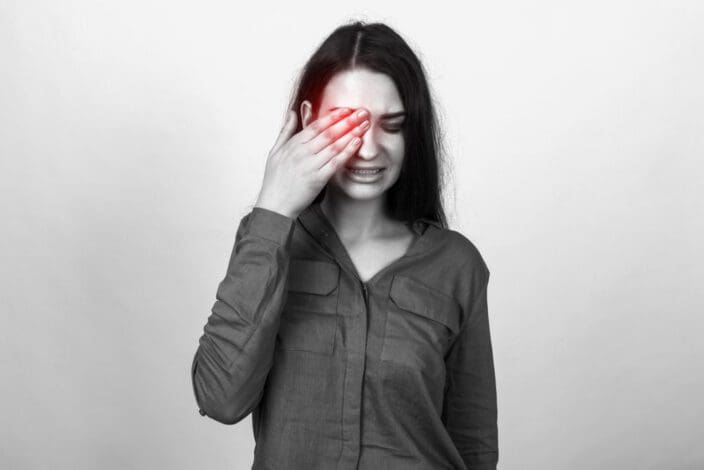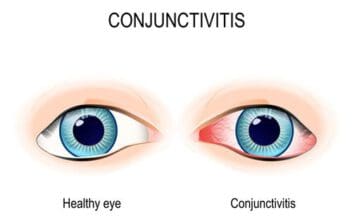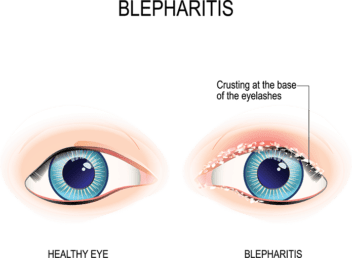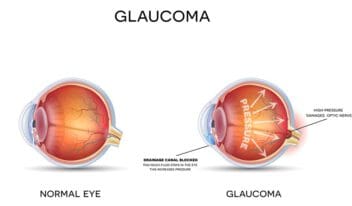Further Reading
- How to Whiten Your Eyes
- Anti-VEGF Treatments
- Medications That Can Affect the Eyes
- Laser Pointers Cause Eye Damage
- Testing for Glaucoma: What Makes a Comprehensive Glaucoma Exam?
- Travel & Eye Health Guide
- What to Know About Tele-optometry
- How to Use Eye Makeup Safely Around Your Eyes
- Understanding Eye Cancer
- Retina Specialists
- Best Senses
- Histology of the Eye
- Is Visine Safe?
- Gunk in the Eyes
- 5 Reasons to See Your Optometrist This Summer
- Why Is It Important to See Your Optometrist Regularly?
- Foreign Objects in Eye: What to Do
- Eye Color Change
- How to Get Rid of a Black Eye
- What Eyes Can Tell About Your Heart Health
- How to Manage Your Child's Screen Time
- Risks & Benefits of Eyelash Extensions
- Blood in the Eyes
- Pinpoint Pupils
- Visible Eye Veins
- Why Are Your Eyes Itchy?
- Tired Eyes
- Bloodshot Eyes
- Eye Twitches: What Causes Them and How To Prevent
- Swollen Eyelids
- Pressure or Pain Behind the Eye
- Bumps Under the Eyes
- Brown Spots on Eye
- Wildfire Smoke & Your Eyes
- Why Squinting Is Not Bad for Your Eyes
- COVID-19 Omicron Variant and Eyes
- Get Rid Of Bags Under Eyes
- Post-COVID Eye Care Guide
- Splinters or Foreign Objects in the Eyes
- Your Eyes & Epilepsy
- Eye Care for Swimmers
- Eyes Burning?
Eye Pain: 9 Likely Causes & How to Find Relief
Home / Eye Health and Preventive Care /
Last Updated:
What are the causes of eye pain?
Eye pain can occur due to a variety of reasons. These are the 9 most likely eye pain causes:
- Foreign Substances
- Conjunctivitis
- Improper use of Contact Lenses
- Corneal Abrasion
- Blepharitis
- Styes
- Glaucoma
- Optic Neuritis
- Migraines
Read on to gain a deeper understanding of these conditions, their symptoms, and ways to diagnose and find relief from eye pain.
Eye pain can be caused by a foreign substance — like dust, sand, wood shavings, or eyelashes — becoming stuck on the surface of the eye. An incorrectly placed contact lens, or one that has not been properly cleaned, can also cause significant pain.
Blepharitis, a condition where the oil glands on the eyelids become blocked can make it painful to open the eyes or move them around. Diabetes can lead to glaucoma, a condition that causes painful pressure on the eyeball.
Migraines are a very common source of eye pain.
Treatments for eye pain include resting the eyes, using a warm compress, and washing the eyes with warm water and saline solution.

Types of Eye Pain
Eye pain, also known as ophthalmalgia, is a common ailment with any number of causes. Most of them are not serious and will resolve with little help. Others are indicators of problems that require timely medical treatment to prevent vision loss.
There are two types of eye pain. Ocular pain occurs on the surface of the eye, and orbital pain takes place within the eye.
Ocular pain tends to be caused by infection, irritation from a foreign substance, or trauma. This is usually treated quite easily.
Orbital pain tends to feel deeper. It requires more involved treatment.
Depending on the cause, you may experience pain in one or both eyes. Discomfort usually originates in the injured, infected or otherwise impacted eye region, such as:
- Cornea: A host of complications affecting the cornea can cause pain in eyes.
- Uvea: This middle layer of the eye can be painful if infected.
- Conjunctiva: Eye pain can originate in this inner layer of the eyelid which also lies on the eyeball’s surface.
- Sclera: The eyeball’s outermost layer can also cause eye pain.
Any loss of vision that occurs with eye pain could be a symptom of a medical issue that an ophthalmologist or a doctor should know about immediately.
9 Causes of Eye Pain
These potential causes of eye pain are all treated somewhat differently:
| Cause | Symptoms | Possible Treatments |
|---|---|---|
| Foreign Substances | Redness, watery eyes, pain | Blinking, immersing the eye in saline, removing with clean fingers |
| Conjunctivitis | Eye discharge, pain, itchiness, redness | Over-the-counter medication, resting eyes |
| Improper use of Contact Lenses | Stinging, burning, itching, discomfort, blurred vision, light sensitivity | Removal of lenses, switching to glasses, cleaning and disinfecting lenses |
| Corneal Abrasion | Pain, excessive tearing, light sensitivity, redness | Rinse eye with clean water or saline, blink rapidly, consult doctor |
| Blepharitis | Burning sensation, tearing, itching, light sensitivity, swollen eyelids | Cleaning eyelids, using dandruff shampoo, maintaining hygiene |
| Styes | Raised, painful bump on eyelid | Warm compress, mild soap and water, avoid makeup and contact lenses |
| Glaucoma | Orbital pain, vision loss | Prescription eye drops, medication, surgery |
| Optic Neuritis | Eye pain, vision loss | Steroid medications to reduce inflammation |
| Migraines | Sensitivity to light, eye pain, temporary vision loss | Cause and treatment not fully understood, see doctor for personalized advice |
1. Foreign Substances
A foreign substance on the surface of the eye can be anything from an eyelash to a piece of dirt or makeup. It can cause redness in the eye, watery eyes, and pain.
The substance tends to affect the cornea (the transparent layer that covers the pupil and the iris) or the conjunctiva (the thin layer covering the sclera, the white part of the eye).
In most cases, foreign objects are harmless and can be removed quite easily. Care must be exercised to avoid scratching the cornea when attempting to remove the object.
Getting a foreign substance out of your eye could be as simple as blinking repeatedly. You may also remove the object with your fingers (after washing your hands with soap and water for 20 seconds).
Sometimes, you can flush out the object by immersing the eye in a small container of sterile saline solution. Dry the eye with a clean cotton swab once the particle has been removed.
2. Conjunctivitis

This is a condition that affects the conjunctiva, the tissue that covers the front of the eye and the underside of the eyelid. This tissue can become infected by a virus or a bacterium, and this infection causes swelling. Inflammation can also be an allergic response.
Inflammation of the conjunctiva can also cause discharge in the eye, pain, itchiness, and redness, giving conjunctivitis the nickname pink eye. The change in color is due to the small blood vessels in the conjunctiva becoming inflamed.
The spread and infection of conjunctivitis can be controlled by employing good handwashing methods and keeping your environment clean of dust. When the condition develops, it can be treated with over-the-counter medication and resting the eyes.
3. Contact Lenses
Improper use of contact lenses, such as wearing them overnight or not disinfecting them, can irritate the surface of the eyes to the point of causing ocular pain. Not following guidelines regarding use, cleaning, and storage of contact lenses can cause discomfort.
Issues can include, but are not limited to:
- Stinging, burning, itching, irritation, and other forms of eye pain.
- Consistent discomfort when using lenses.
- A feeling that something is stuck in the eye (apart from the lens itself).
- Excessive watering of the eyes.
- Moderate loss of vision.
- Sensitivity to light.
Eye pain caused by improper use of contact lenses can be resolved by immediately removing the lenses and temporarily switching to glasses.
If the contact lens is damaged in any way, put it back in its storage case and contact your doctor. If the lens has a foreign substance on it — like dirt, an eyelash, pollen, makeup, or other particles — it can be cleaned, rinsed, and disinfected before returning it to the eye. If the problem continues, remove the lens immediately and notify your doctor.
4. Corneal Abrasion
A corneal abrasion affects the cornea, the clear surface that covers the eye. A small scratch on the cornea is a corneal abrasion. It’s often caused by dust, sand, dirt, wood shavings, contact lenses, or even the sharp edge of a piece of paper.
This scratch will cause pain, excessive tearing, and sensitivity to light. It can turn the eyes red because of damage to the blood vessels there.
A corneal abrasion requires quick attention. Without relief, the abrasion can become infected and lead to a corneal ulcer.
When the cornea is perforated, you should immediately rinse your eye with clean water or saline solution, blink rapidly to dislodge small particles, and pull your upper eyelid over your lower eyelid. Inducing tears like this can help to wash out the substance.
5. Blepharitis

Blepharitis is a condition whereby the eyelids are infected. It can lead to other conditions that cause pain to the eyes, like a stye, which is a painful bump on the eyelid.
There are two types of blepharitis. Anterior blepharitis affects the outside front of the eyelid, and it is caused by bacteria and dandruff. Posterior blepharitis is the result of oil glands in the inner eyelid.
Either form of blepharitis causes a burning sensation on the eyelids (which can feel like the eye itself is in pain), tearing, itching, sensitivity to light, and swollen eyelids.
Keeping the eyelids clean and free of discharge is key to treating blepharitis. Dandruff shampoo can help to reduce the chances of flakes landing on the eyelids.
Blepharitis does not usually go away completely, and it can recur. Patients must be vigilant about their hygiene on a consistent basis.
6. Styes
A stye is a raised, painful bump on the eyelid, usually caused by a blepharitis infection. It looks like a pimple and is very sensitive to touch. It develops as the result of an oil gland around the eyelashes becoming blocked by dirt or dead skin.
Styes can be treated by using a warm compress (which dissolves the pus clogging the gland, so the oil can drain naturally), mild soap and water, and even a warm tea bag.
If you have a stye, do not use makeup. Cosmetic products can irritate the eye and slow down the healing and drainage process for the oil glands. When the stye heals, use this as an opportunity to discard eye products that are over three months old.
Similarly, avoid using contact lenses until the stye heals. Bacteria from the stye can move to the contact lenses, which will then move to your fingers as you remove the lenses. This greatly increases the risk of exposing someone else to the bacteria.
Under no circumstances should you touch, squeeze, or try to pop a stye. Doing so will discharge pus and spread the infection. A doctor can safely drain the stye in their office.
7. Glaucoma

Orbital pain, or pain felt within the eyeball itself, can have a number of causes and conditions behind it.
An example is glaucoma, which develops as a result of increasing pressure inside the eye (known as intraocular pressure). This can be very painful, and it can lead to permanent vision loss if it is not treated immediately.
It’s very important to get regular eye exams to catch the early warning signs of glaucoma. If treated early, the long-term prognosis is positive. At 40 years old, everyone should have a comprehensive eye exam to serve as a baseline. Your eye doctor will then inform you when you should come back for your next exam.
Treatment options for glaucoma include prescription eye drops, medication, surgery, or a combination of approaches.
8. Optic Neuritis
The optic nerve connects the back of the eyeball to the brain. If this nerve becomes inflamed, it can cause eye pain and a loss of vision. This condition is known as optic neuritis. It is usually caused by an autoimmune disease or a viral or bacterial infection.
Optic neuritis usually resolves on its own, but a doctor can prescribe steroid medications to reduce the inflammation.
9. Migraines
Migraines are a common source of eye pain. An ocular migraine can cause sensitivity to light, which takes the form of pain in the eyes. A migraine can even lead to temporary vision loss.
The causes of ocular migraines are not fully understood, but experts believe they are linked to spasms in blood vessels in the retina. This might also explain how and why migraines cause pain in the eyes.
Other Causes of Eye Pain
Uveitis (Inflammation of the Uvea)
When uvea—the middle layer of the eye—swells, such as due to infection, you can experience pain around the eye. Your discomfort may get worse when you focus on something. Swelling will come with any trauma, but it can be an indication of an infection.
Dry Eye
Several issues can cause dry eye, such as wearing contact lenses (or wearing them too long). Extended dry eye can result in some pain. This condition can even cause you to feel as though you have a foreign object in the eye and result in the tearing of eye tissue.
Brain Tumors
Numerous studies have shown a relationship between some types of brain tumors and eye pain.
Build Up of Pressure in the Brain
Too much pressure in the brain may result in discomforts such as eye pain. Several factors can contribute to this complication, including severe head injury. Some people will experience this pain when they move their eyes.
How to Diagnose Pain in Eyes
Your doctor may perform a series of tests to determine the root cause of your eye pain before prescribing an appropriate remedy. Common tests/diagnostics for pain in eyes include:
- Contact lens history: If you wear or have worn contact lenses, your doctor will try to establish a connection between it and eye infection.
- Kinetic red test: This, along with the static finger wiggle test, can help reveal any visual field shortcomings.
- Penlight test: If your eyes don’t demonstrate abnormal sensitivity to light, then uveitis or keratitis may not be responsible for your eye pain.
- Swinging flashlight test: An optician may apply this technique to assess the presence of optic neuritis. However, a negative result in a patient with eye pain doesn’t necessarily rule out optic neuritis.
How to Find Relief From Eye Pain

There are many causes of eye pain, and they are very diverse. In general, treatments for eye discomfort have some similarities.
- Give your eyes a break. Resting your eyes is one of the simplest and most straightforward ways to address eye pain. Taking a break from computers, phones, and television screens for a day will reduce eye strain and cut down on the risk of headaches, which will go a long way in relieving eye pain. Make such breaks a regular part of your day.
- Avoid contacts. Your corneas need time to rest. Use glasses instead of your contact lenses, so your corneas have less work to do.
- Use warm compresses. In many cases, a warm compress will help to reduce pain, swelling, itching, and discharge. This will help to clear any blockages in the skin.
- Flush out particles. Use warm water or saline solution to flush out any foreign particles stuck on the surface of the eye. This can help to remove the source of the eye pain.
- Use medications as prescribed. Medications like antibiotics can treat infections of the eye that are causing pain. They are useful for conditions like corneal abrasions and conjunctivitis.
Patients who have glaucoma will be prescribed eye drops to reduce intraocular pressure and pain in their eyes. If the pain is so severe that it impacts day-to-day activities, you might be prescribed pain medications. This can give some relief until the underlying cause behind the discomfort is addressed. - Undergo surgery, if recommended. Surgery is a last resort, but it is sometimes necessary. If a foreign substance on the surface of your eye has caused damage that needs to be immediately repaired, surgery may be the best option.
The recuperation period after surgery will require that the patient does not engage in any activity that demands visual focus and concentration. They will have to rest their eyes in low-light environments for a long time.
The eyes will need to be treated with care for months following surgery, to ensure that the conditions that caused the eye pain do not return.
References
- Corneal Abrasion. (January 2019). Harvard Medical School.
- What Is Corneal Abrasion? (April 2019). American Academy of Ophthalmology.
- Blepharitis. (July 2019). National Eye Institute.
- Glaucoma. (June 2016). MedicineNet.
- Optic Neuritis. MedicineNet.
- Understanding Ocular Migraine. (October 2017). American Migraine Foundation.
- Evaluation of Painful Eye. (June 15, 2016). American Family Physician.
- Uveitis. (January 3, 2020). NHS.
- The Most Common Causes of Eye Pain at 2 Tertiary Ophthalmology and Neurology Clinics. (September, 2018). Journal of Neuro-Ophthalmology.
- Intracranial Hypertension. (October 21, 2019). NHS.
- Foreign Object in the Eye: First Aid. (September 1, 2020). Mayo Clinic.
- Sty. (July 15, 2020). Mayo Clinic.
- Glaucoma. Mayo Clinic. (October 23, 2020).
- Optic Neuritis. (July 2017). NHS.
- Ocular Migraine. (July 2021). American Optometric Association.
The information provided on this page should not be used in place of information provided by a doctor or specialist. To learn more, read our Privacy Policy and Editorial Policy pages.
Further Reading
- How to Whiten Your Eyes
- Anti-VEGF Treatments
- Medications That Can Affect the Eyes
- Laser Pointers Cause Eye Damage
- Testing for Glaucoma: What Makes a Comprehensive Glaucoma Exam?
- Travel & Eye Health Guide
- What to Know About Tele-optometry
- How to Use Eye Makeup Safely Around Your Eyes
- Understanding Eye Cancer
- Retina Specialists
- Best Senses
- Histology of the Eye
- Is Visine Safe?
- Gunk in the Eyes
- 5 Reasons to See Your Optometrist This Summer
- Why Is It Important to See Your Optometrist Regularly?
- Foreign Objects in Eye: What to Do
- Eye Color Change
- How to Get Rid of a Black Eye
- What Eyes Can Tell About Your Heart Health
- How to Manage Your Child's Screen Time
- Risks & Benefits of Eyelash Extensions
- Blood in the Eyes
- Pinpoint Pupils
- Visible Eye Veins
- Why Are Your Eyes Itchy?
- Tired Eyes
- Bloodshot Eyes
- Eye Twitches: What Causes Them and How To Prevent
- Swollen Eyelids
- Pressure or Pain Behind the Eye
- Bumps Under the Eyes
- Brown Spots on Eye
- Wildfire Smoke & Your Eyes
- Why Squinting Is Not Bad for Your Eyes
- COVID-19 Omicron Variant and Eyes
- Get Rid Of Bags Under Eyes
- Post-COVID Eye Care Guide
- Splinters or Foreign Objects in the Eyes
- Your Eyes & Epilepsy
- Eye Care for Swimmers
- Eyes Burning?